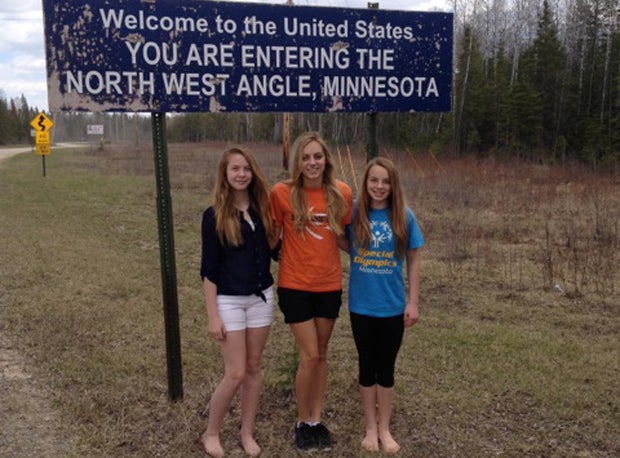
Meaghan Carlson, Madison Goulet and Kelby Goulet (left to right) leave America and re-enter the country every time they go from home to school. The only way to get home from track practice without driving into Canada is taking a boat.
Photo courtesy of Lisa Goulet
Travel for high school athletic teams long has been controversial and many states limit the amount and distance. Some definitely have a rough time, but maybe not as rough as students from a pair of high schools.

Myles Peltier goes past the Peach Arch each dayhe heads to school. The arch is located exactly onthe international border.
Photo courtesy of Myles Peltier
How about driving through a different country just to get to school, for example.
* Some of the athletes in
Warroad (Minn.) live in the Northwest Angle (a small resort community), which forces them to travel through two checkpoints - including one in Canada - to reach their school.
*
Blaine (Wash.) athletes who live in Point Roberts, a two-mile peninsula, experience the same difficulty as they also must travel through part of Canada and a pair of checkpoints.
They basically are tiny inlets near the Canadian border that are not connected to the United States by land.
Three Northwest Angle residents - sisters Madison and Kelby Goulet and their cousin, Meghan Carlson - all run track for Warroad High School, which is 63 miles away.
Until entering seventh grade at Warroad, they attended a one-room schoolhouse (the only one in the state and, perhaps, the nation) in the Northwest Angle. In recent years that building has housed as many as 17 and as few as three students during a single school year.

The three Warroad girls entering Canada.
Photo courtesy of Lisa Goulet
The travel problem begins in seventh grade and only for those who compete in sports. There is a bus that will pick up the Northwest Angle students and bring them to school and one that will take them home after school. But there is no bus to transport athletes at night following practice or games.
Out of necessity, the Goulet sisters stay in Warroad with their grandmother, Millie Knedle, Monday through Thursday. There is no school on Friday (the first four days run longer to make up the time deficit).
Madison, a junior who competes in the 800-meters, 1,600-meters and one relay, told MaxPreps that the biggest drawback is "not seeing your family. I'd have to drive home every night if I didn't have family in Warroad. It's hard. I have seven younger siblings (six still at home). I do drive a few times if the kids have a play or something."
Though she enjoyed being the only person in her class from grades K-6, Madison noted that she started running track when she came to Warrorad in seventh grade and was able to make many new friends. During her freshman year, she helped the 3,200 relay set a school record. In addition to track, she keeps statistics for the boys hockey team.
Kelby is an eighth-grader who runs the 100 and 200 and also competes in the high jump.
She, too, admits, "It gets pretty lonely" without being able to go home every night.
Carlson is a seventh-grader in her first year at Warroad and is still figuring out which track events will best suit her. She does not stay in town very often because she also is taking dance and piano lessons, according to her mother, Mary Carlson, who often picks her up.
Warroad has had at least four snow days this year, Mary said, because temperatures often hit between 20 and 30 below zero.
"You just get used to that kind of condition," she said.
Mary's older daughter, Nicole, also competed in track at Warroad before graduating.
Track coach Alan Rybolt recalled, "She always wanted to drive back to the Angle after practice (two or three times a week). It always had me concerned, but her parents were OK with it."
Myles Peltier, a senior baseball player at Blaine High in Washington, has his own unique travel problems. He entered high school too late to take advantage of the practice bus, which the school dropped due to budget cuts. He has attended Blaine schools since second grade, hopped a bus until sixth grade and was able to carpool until this year.
Peltier has to drive only about 27 miles this year to reach his Point Roberts home, but must do it six days a week. The weather is not nearly as big of a problem (only two snow days) as time and money.
"I spend all my money on gas," he sighed. "It costs from $15-20 a day. My family helps and during the summer and spring I mow lawns and make pizza at the pier."
A 40-minue drive some times becomes an extended nightmare. He recalled, "On holidays the border gets backed up. On Easter it took me three hours just to get through. A lot of Canadians come to the U.S. to shop and buy gas, which is cheaper in the states."
Peltier does have a Nexus pass, which greatly speeds up border travel. However, if he gets to the checkpoint after 7 p.m., he must wait in the tourist line, which often adds 30 to 45 minutes to his journey.
Until recently he never owned a cell phone. He readily admitted, "It was a stressful situation just having to go all the way back to 'The Point' every day with no cell phone."
Even his athletic career has been a battle. Peltier started playing football in seventh grade (quarterback and linebacker), but he tore his ACL in eighth grade and tore the other ACL in 10th grade.
He had to wear a brace as a freshman baseball player and missed his entire sophomore year of baseball.
A third baseman and right-handed pitcher, the 5-foot-8, 150-pounder said that his junior-year highlight was pitching six scoreless innings in relief against Lynden.
So far this spring he still is experiencing hard luck.
He admitted, "I'm disappointed. I'm hitting the ball hard but it's always right at somebody."

Peltier poses at the entrance into Canada.
Photo courtesy of Myles Peltier
